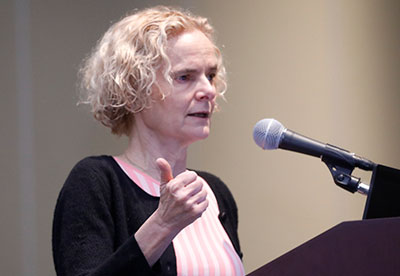NIDA Director Outlines Institute’s Efforts to Understand Pain, Reduce Opioid Misuse

For her Presidential Session at this year’s Annual Meeting, National Institute on Drug Abuse (NIDA) Director Nora Volkow, M.D., provided an overview and update on the new HEAL Initiative (Helping to End Addiction Long-Term) of the National Institutes of Health (NIH). Launched in April 2018, HEAL is a congressionally initiated and supported project that provides $500 million annually to NIH to improve pain management and find better treatments for opioid misuse and addiction.
“There are still so many fundamental questions related to pain for which we don’t know the answers,” Volkow (pictured above) told the audience. “For example, what are the molecular processes that trigger the inflammatory response that contributes to chronic pain?”
The lack of such knowledge helped contribute to the opioid epidemic, Volkow noted, as many companies and physicians charged ahead under the logical assumption that these medications—which are extremely effective for acute pain—would be the medications of choice for chronic pain. At that time, there were limited alternatives, Volkow added, and that’s still true today. While medications like nonsteroidal antiinflammatory drugs (NSAIDS) are available, they work for only a few types of pain, and not every patient responds, she said.
“We need new treatments, and through HEAL we are incentivizing pharmaceutical companies to make pain relief a priority area of research,” she said. Further, NIDA is using HEAL resources to expand and enhance its national Clinical Trials Network to help researchers find participants and initiate large clinical trials needed for drug approval. NIDA is also coordinating with the Food and Drug Administration to help expedite the review of promising medications.
Regarding opioid misuse, Volkow said, the good news is that a number of effective pharmacologic treatments are available (methadone, buprenorphine, and naltrexone) and available in a range of formulations. NIDA is not content with the status quo, however. “We need to continue to diversify our current arsenal,” she said. One priority area she noted is methadone, which still needs to be taken once daily and only at approved methadone clinics.
“If someone like me can have trouble remembering to take a daily antibiotic, imagine being a person in drug recovery who has to travel a long distance every day to get methadone,” she said. “If we could develop a longer-acting methadone or a formulation with less risk of diversion that could be taken at home, we would help many patients stay compliant.”
Volkow also highlighted NIDA’s efforts to explore electrical and magnetic stimulation as tools to modulate brain pathways involved in reward processing; this might help reduce anxiety or other behaviors that contribute to the risk of relapse. NIDA researchers are also testing antibodies as a therapeutic relapse strategy. Antibodies can bind to drugs like heroin in the bloodstream and prevent them from entering the brain. Volkow said that preliminary studies suggest this approach can be effective, but current antibodies don’t last long after injection. Some new techniques used in HIV research have found ways to make antibodies last up to six months, and NIDA is trying to replicate that feat.
Volkow wrapped up the session with a look at NIDA’s most ambitious HEAL-related projects to date. The first is a study known as HEALing Communities, which launched earlier this year. While there have been several advancements in treating opioid use disorder (OUD) in the past few years, she said, they have been conducted in specific settings—for example, a hospital emergency department or a jail. “Can we integrate effective OUD care across multiple health care, forensic, and community settings?” she asked. Through this new study, research centers in four states—Kentucky, Massachusetts, New York, and Ohio—will try and implement a set of evidence-based strategies to reduce overdoses, decrease OUD prevalence, increase access to OUD medications, and get more people into recovery-support services; this implementation will be attempted in multiple counties, both urban and rural, in each state.
Another effort will launch this summer and was inspired by NIH’s Adolescent Brain Cognitive Development Study, or ABCD. That prospective study is following children aged 9 and 10 until they become young adults to see how their brains mature in both wellness and illness. While ABCD will provide invaluable data on how substance use and psychiatric disorders affect brain development, “life doesn’t start at age 10,” Volkow said.
Therefore, NIDA will soon start enrolling subjects for the Healthy Brain and Child Development Study (HBCD). This study will enroll pregnant women across the country and follow them and their babies for 10 years to assess newborn brain development. The study will heavily recruit women with OUD to assess the long-term, transgenerational effects of addiction.
“I really like HEAL because this initiative is more than simply stemming the current opioid crisis,” Volkow said, stressing the use of the phrase “long-term” in the HEAL name. “This initiative will give us the tools to change the trajectory of how we treat all addictions.”
(Image: David Hathcox)
|
|
|
|
|


